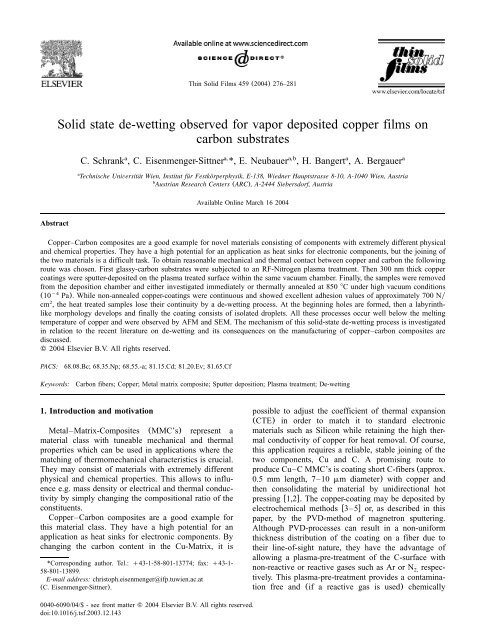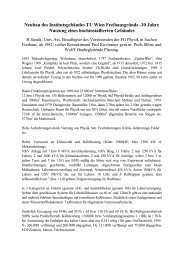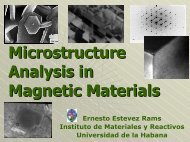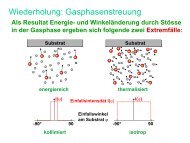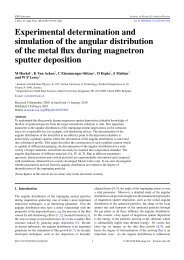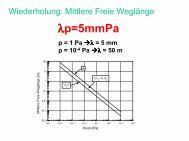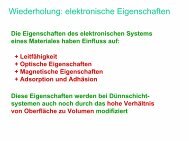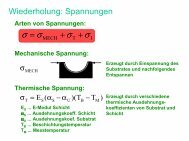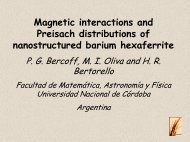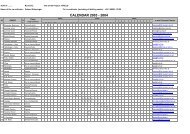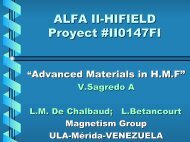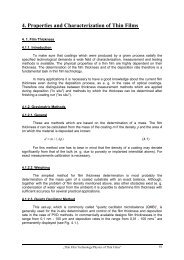Solid state de-wetting observed for vapor deposited copper films on ...
Solid state de-wetting observed for vapor deposited copper films on ...
Solid state de-wetting observed for vapor deposited copper films on ...
- No tags were found...
You also want an ePaper? Increase the reach of your titles
YUMPU automatically turns print PDFs into web optimized ePapers that Google loves.
280 C. Schrank et al. / Thin <str<strong>on</strong>g>Solid</str<strong>on</strong>g> Films 459 (2004) 276–281Fig. 6. Sec<strong>on</strong>d Minkowski-functi<strong>on</strong>als calculated <str<strong>on</strong>g>for</str<strong>on</strong>g> (a) ensembles of holes in 300 nm thick Cu-coatings after approx. 2 min heat treatment (——) in comparis<strong>on</strong> with a random point ensemble (l<strong>on</strong>g dashed line) and a point ensemble of vertices in a polycrystal (------); (b) ensembles ofdroplets resulting from a 300 nm thick Cu-coating after 60 min heat treatment (——) in comparis<strong>on</strong> with a random point ensemble (l<strong>on</strong>g dashedline) and a point ensemble calculated from the geometric centers of grains in a polycrystal (short dashed line).ularly spaced (i.e. the more correlated) the points are,the lower the width of the curve will be.Both, Fig. 6a <str<strong>on</strong>g>for</str<strong>on</strong>g> the hole positi<strong>on</strong>s and Fig. 6b <str<strong>on</strong>g>for</str<strong>on</strong>g>the droplet positi<strong>on</strong>s show a significant correlati<strong>on</strong> ofthe object positi<strong>on</strong>s when compared to the functi<strong>on</strong>alobtained <str<strong>on</strong>g>for</str<strong>on</strong>g> a random point distributi<strong>on</strong>. In the case ofthe holes, the origin of this correlati<strong>on</strong> is yet unclearand may be related to residual stress in the film. Holeswhich were located at the vertices of a simulatedpolycrystal (see below) are obviously also randomlydistributed (Fig. 6a, wi<str<strong>on</strong>g>de</str<strong>on</strong>g> dashed line). The correlati<strong>on</strong>of the droplet positi<strong>on</strong> can be explained by the mechanism<str<strong>on</strong>g>de</str<strong>on</strong>g>picted in Fig. 8: in Fig. 8a a polycrystallinearray obtained from a 48-<str<strong>on</strong>g>state</str<strong>on</strong>g> Potts-mo<str<strong>on</strong>g>de</str<strong>on</strong>g>l of regulargrain growth w16x after 35 000 M<strong>on</strong>te Carlo Steps isshown. The white points encircled by a black regi<strong>on</strong>indicate the geometric center of each grain and aschematic circular droplet, respectively. Fig. 8b showsthe ensemble of droplets of Fig. 3c. If <strong>on</strong>e assumes thatthe whole amount of material of each grain is c<strong>on</strong>centratedin a droplet then the correlati<strong>on</strong> of droplets shouldbe reflected by the correlati<strong>on</strong> of the geometric centersof the grains in the mo<str<strong>on</strong>g>de</str<strong>on</strong>g>l. In fact the dashed line inFig. 6b was obtained from the point distributi<strong>on</strong> in Fig.8a and shows a reas<strong>on</strong>able similarity to the 2nd Minkowskifuncti<strong>on</strong>al obtained from the droplet array inFig. 7. SEM image of droplets resulting from a 300 nm thick Cucoatingafter 60 min heat treatment. The encircled regi<strong>on</strong> indicates afeature, which is a remanent of a Rayleigh-instability, which <str<strong>on</strong>g>for</str<strong>on</strong>g>medduring the separati<strong>on</strong> of two previously c<strong>on</strong>nected droplets.Fig. 8. Visualizati<strong>on</strong> of a mo<str<strong>on</strong>g>de</str<strong>on</strong>g>l, which explains the correlati<strong>on</strong> ofdroplet positi<strong>on</strong>s in the final phase of <str<strong>on</strong>g>de</str<strong>on</strong>g>-<str<strong>on</strong>g>wetting</str<strong>on</strong>g> (a) mo<str<strong>on</strong>g>de</str<strong>on</strong>g>l of a polycrystallinefilm. Each white dot indicates the geometric center of agrain. The black circles around the geometric centers shall symbolizethe droplets resulting from the spheroidizati<strong>on</strong> of the single grain. (b)Topographic AFM-image of an actual droplet array (see Fig. 3c).
C. Schrank et al. / Thin <str<strong>on</strong>g>Solid</str<strong>on</strong>g> Films 459 (2004) 276–281281Fig. 8b. There<str<strong>on</strong>g>for</str<strong>on</strong>g>e at least the correlati<strong>on</strong> of the dropletsin the late phase of <str<strong>on</strong>g>de</str<strong>on</strong>g>-<str<strong>on</strong>g>wetting</str<strong>on</strong>g> is un<str<strong>on</strong>g>de</str<strong>on</strong>g>rstandable by themechanism of recrystallizati<strong>on</strong> and film rupture al<strong>on</strong>gthe grain boundaries.4. C<strong>on</strong>clusi<strong>on</strong> and outlookIn the present paper, it was shown that N -plasma2pre-treatment is a powerful tool to improve the mechanicaladhesi<strong>on</strong> of Cu <strong>on</strong> C. Thermal treatment, <strong>on</strong> theother hand, leads to <str<strong>on</strong>g>de</str<strong>on</strong>g>-<str<strong>on</strong>g>wetting</str<strong>on</strong>g> of the Cu-film from theC-substrate and, there<str<strong>on</strong>g>for</str<strong>on</strong>g>e to a significant reducti<strong>on</strong> ofadhesi<strong>on</strong> values. The mechanism of the <str<strong>on</strong>g>de</str<strong>on</strong>g>-<str<strong>on</strong>g>wetting</str<strong>on</strong>g>process was found to be str<strong>on</strong>gly correlated to therecrystallizati<strong>on</strong> of the Cu-film. This leads to the nucleati<strong>on</strong>of holes at selected vertices of the recrystallizedcoating. Via film rupture al<strong>on</strong>g the grain boundaries, anarrangement of insulated droplets is <str<strong>on</strong>g>for</str<strong>on</strong>g>med in the latephase of thermal treatment if the film is sufficientlythin.It is, there<str<strong>on</strong>g>for</str<strong>on</strong>g>e of great technological importance toinhibit the first phase of <str<strong>on</strong>g>de</str<strong>on</strong>g>-<str<strong>on</strong>g>wetting</str<strong>on</strong>g>, i.e. the <str<strong>on</strong>g>for</str<strong>on</strong>g>mati<strong>on</strong>of holes. The fact that not all vertices in the polycrystalare the nuclei of holes indicates that hole <str<strong>on</strong>g>for</str<strong>on</strong>g>mati<strong>on</strong> isat least partially surface diffusi<strong>on</strong> driven. Holes nucleateat positi<strong>on</strong>s where grains terminated by surface planeswith high diffusivity meet. One approach is, there<str<strong>on</strong>g>for</str<strong>on</strong>g>eto add materials to the Cu-coating, which reduce surfacediffusivity.However, hole nucleati<strong>on</strong> is most probably not <strong>on</strong>lydue to surface diffusi<strong>on</strong> as it is indicated by the n<strong>on</strong>randomcorrelati<strong>on</strong> of holes. This correlati<strong>on</strong> is notobtained by c<strong>on</strong>structing point ensembles of vertices,which are boun<str<strong>on</strong>g>de</str<strong>on</strong>g>d by grains of selected crystallographicdirecti<strong>on</strong>s by a modified grain growth mo<str<strong>on</strong>g>de</str<strong>on</strong>g>l. A reas<strong>on</strong><str<strong>on</strong>g>for</str<strong>on</strong>g> this correlati<strong>on</strong> might be residual stress in thecoating, which surely is also a driving <str<strong>on</strong>g>for</str<strong>on</strong>g>ce <str<strong>on</strong>g>for</str<strong>on</strong>g> <str<strong>on</strong>g>de</str<strong>on</strong>g><str<strong>on</strong>g>wetting</str<strong>on</strong>g>,as Srolovitz <str<strong>on</strong>g>state</str<strong>on</strong>g>s in w14x. There<str<strong>on</strong>g>for</str<strong>on</strong>g>e a <str<strong>on</strong>g>de</str<strong>on</strong>g>terminati<strong>on</strong>of residual stresses in the Cu-Coatings will bea topic of further work, al<strong>on</strong>g with an adjustment of<str<strong>on</strong>g>de</str<strong>on</strong>g>positi<strong>on</strong> parameters to minimize intrinsic stresses.AcknowledgmentsThis Work is supported by the Austrian ‘F<strong>on</strong>ds zurFor<str<strong>on</strong>g>de</str<strong>on</strong>g>rung ¨ <str<strong>on</strong>g>de</str<strong>on</strong>g>r Wissenschaftlichen Forschung’ (FWF)un<str<strong>on</strong>g>de</str<strong>on</strong>g>r Grant Nr.: P-14534.Referencesw1x S.J. Sun, M.D. Zhang, J. Mater. Sci. 26 (1991) 5762.w2x Y.L. Petitcorps, J.M. Poueylaud, L. Albingre, B. Ber<str<strong>on</strong>g>de</str<strong>on</strong>g>u, P.O.Lobstein, J.F. Silvain, Key Eng. Mater. 127-131 (1997) 327.w3x Z. Zhu, X. Kuang, G. Carotenuto, L. Nicolais, J. Mater. Sci32 (1997) 1061.w4x Y.Z. Wan, Y.L. Wang, H.L. Luo, X.H. D<strong>on</strong>g, G.X. Cheng,Mater. Sci. Eng. A288 (2000) 26.w5x G. Korb, J. Korab, G. Groboth, Composites 29A (1998) 1563.w6x Leaflet: HTW Hochtemperaturwerkstoffe GmbH (data-sheetavailable <strong>on</strong> www.htw-germany.com).w7x R. Dubgen, ¨ G. Popp, Glasartiger Kohlenstoff SIGRADUR (R)– ein Werkstoff fur ¨ Chemie und Technik In<str<strong>on</strong>g>for</str<strong>on</strong>g>mati<strong>on</strong> leafletof HTW Hochtemperaturwerkstoffe, Germany.w8x E. Neubauer, G. Korb, C. Eisenmenger-Sittner, H. Bangert, S.Chotikaprakhan, D Dietzel, A.M. Mansanares, B. Bein, Thin<str<strong>on</strong>g>Solid</str<strong>on</strong>g> Films, in press, doi:10.1016yS0040-6090(03)00318-3.w9x S. Herminghaus, K. Jacobs, K. Mecke, J. Bischof, A. Fery, M.Ibn-Elhaj, S. Schlagowski Sci. 282 (1998) 916.w10x J. Bischof, D. Scherer, S. Herminghaus, P. Lei<str<strong>on</strong>g>de</str<strong>on</strong>g>rer, Phys. Rev.Lett. 77 (8) (1996) 1536.w11x B. Du, F. Xi, Y. Wang, Z. Yang, O.K.C. Tsui, Langmuir 18(2002) 8510.w12x U. Thiele, M. Mertig, W. Pompe, Phys. Rev. Lett. 80 (13)(1998) 2869.w13x K. Jacobs, S. Herminghaus, K.R. Mecke, Langmuir 14 (1998)965.w14x D.J. Srolovitz, M.G. Goldiner, J. Mater. 47 (3) (1995) 31.w15x Lord Rayleigh, Proc. L<strong>on</strong>d. Math. Soc. 10 (1878) 4.w16x D.J. Srolovitz, J. Vac. Sci. Technol. A4 (6) (1986) 2925.


